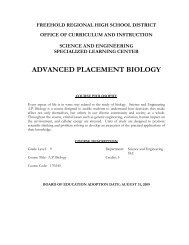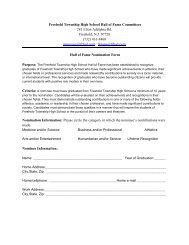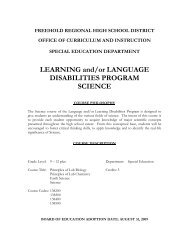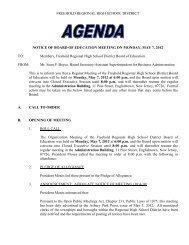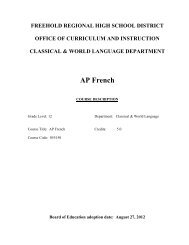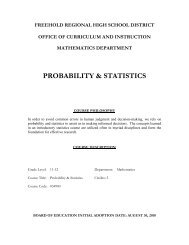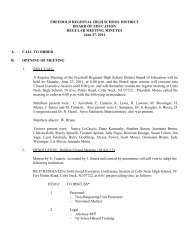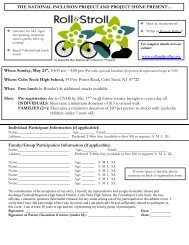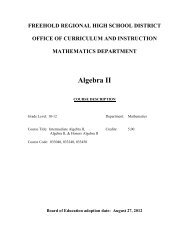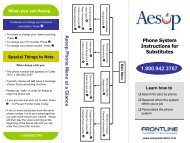- Page 1 and 2: FREEHOLD REGIONAL HIGH SCHOOL DISTR
- Page 3 and 4: AP Physics B- IntroductionIntroduct
- Page 5 and 6: Quizzes5.1 A‐D5.2 EThe same basic
- Page 7 and 8: Quizzes5.1 A‐D5.2 EAn object intr
- Page 9 and 10: Quizzes5.1 A‐D5.2 C‐EEnergy is
- Page 11 and 12: Quizzes5.1 A‐D5.2 A‐EThe kineti
- Page 13 and 14: 5.1 A‐D5.2 D, EA charged bodyprod
- Page 15 and 16: Proficiencies and PacingUnit TitleA
- Page 17 and 18: Unit 7: Torque &EquilibriumUnit 8:
- Page 19 and 20: Unit 17: LightLight behaves as an e
- Page 21 and 22: Unit 3: Two Dimensional MotionTwo D
- Page 23: Unit 11: FieldsElectric Field and E
- Page 27 and 28: Guiding/TopicalQuestionsWhat practi
- Page 29 and 30: 2010 College‐ and Career‐Readin
- Page 31 and 32: Unit 01- KinematicsUnit 1: One Dime
- Page 33 and 34: Define key termsregarding the motio
- Page 35 and 36: DifferentiationFacilitate group dis
- Page 37 and 38: Guiding/TopicalQuestionsContent/The
- Page 39 and 40: What are the typesof friction?Why d
- Page 41 and 42: TechnologyUse of Microsoft Excel (o
- Page 43 and 44: Guiding/TopicalQuestionsContent/The
- Page 45 and 46: 2010 College‐ and Career‐Readin
- Page 47 and 48: Unit 04- Circular Motion & Universa
- Page 49 and 50: What is thedifferencebetween thecon
- Page 51 and 52: 2010 College‐ and Career‐Readin
- Page 53 and 54: Unit 05- MomentumUnit 5: MomentumEn
- Page 55 and 56: How is Newton's3rd and 2nd Lawrelat
- Page 57 and 58: DifferentiationFacilitate group dis
- Page 59 and 60: Guiding/TopicalQuestionsContent/The
- Page 61 and 62: What is thedifference betweenan ene
- Page 63 and 64: TechnologyUse of Microsoft Excel (o
- Page 65 and 66: Guiding/TopicalQuestionsContent/The
- Page 67 and 68: 2010 College‐ and Career‐Readin
- Page 69 and 70: Unit 08- Fluid DynamicsFluid Dynami
- Page 71 and 72: Interactive white boardpresentation
- Page 73 and 74: How does a fluidexert an upwardforc
- Page 75 and 76:
What happens tothe pressureexerted
- Page 77 and 78:
College and Workplace ReadinessRead
- Page 79 and 80:
Guiding/TopicalQuestionsContent/The
- Page 81 and 82:
What is therelationshipbetween ther
- Page 83 and 84:
What is theheating/coolingprocess?R
- Page 85 and 86:
What is the firstlaw ofthermodynami
- Page 87 and 88:
Class discussion on interactions of
- Page 89 and 90:
What isefficiency?What is entropy?U
- Page 91 and 92:
TechnologyUse of Microsoft Excel (o
- Page 93 and 94:
Guiding/TopicalQuestionsContent/The
- Page 95 and 96:
How is chargedtransferred?Understan
- Page 97 and 98:
Observation labs:PVC is rubbed with
- Page 99 and 100:
Formative assessment tasks:Lab writ
- Page 101 and 102:
Class discussion on using energy ba
- Page 103 and 104:
2010 College‐ and Career‐Readin
- Page 105 and 106:
Unit 11- FieldsUnit 11: FieldsEndur
- Page 107 and 108:
How are electricalfieldsrepresented
- Page 109 and 110:
How do youdetermine theelectric fie
- Page 111 and 112:
How is an electricpotential fieldre
- Page 113 and 114:
2010 College‐ and Career‐Readin
- Page 115 and 116:
Unit 12- CircuitsUnit 12: CircuitsE
- Page 117 and 118:
What is electricalcurrent?Describe
- Page 119 and 120:
Formative assessmenttasks:When is a
- Page 121 and 122:
What is Ohm’sLaw?Relate current a
- Page 123 and 124:
What areKirchhoff’s rulesand how
- Page 125 and 126:
Formative assessmenttasks:What is t
- Page 127 and 128:
Formative assessmenttasks:What is e
- Page 129 and 130:
College and Workplace ReadinessRead
- Page 131 and 132:
Guiding/TopicalQuestionsContent/The
- Page 133 and 134:
Formative assessmenttasks:Lab write
- Page 135 and 136:
Formative assessmenttasks:What is a
- Page 137 and 138:
Unit 14- ElectromagnetismUnit 14: E
- Page 139 and 140:
What are thecharacteristics anddiff
- Page 141 and 142:
What is the magnetic fieldaround a
- Page 143 and 144:
What is an electromagnetand how is
- Page 145 and 146:
2010 College- and Career-Readiness
- Page 147 and 148:
Unit 15- Simple Harmonic MotionUnti
- Page 149 and 150:
Collect data fromoscillating spring
- Page 151 and 152:
2010 College‐ and Career‐Readin
- Page 153 and 154:
Unit 16- Mechanical WavesUnit 16: M
- Page 155 and 156:
What are theparts of a wave?What is
- Page 157 and 158:
How does energyrelate to theamplitu
- Page 159 and 160:
Observe objects that areaffected by
- Page 161 and 162:
TechnologyUse of Microsoft Excel (o
- Page 163 and 164:
Guiding/TopicalQuestionsContent/The
- Page 165 and 166:
How are colorsrelated to light?What
- Page 167 and 168:
DifferentiationFacilitate group dis
- Page 169 and 170:
Guiding/TopicalQuestionsContent/The
- Page 171 and 172:
What is a mirrorand how does itinte
- Page 173 and 174:
TechnologyUse of Microsoft Excel (o
- Page 175 and 176:
Guiding/TopicalQuestionsContent/The
- Page 177 and 178:
What is thephotoelectriceffect?Rela
- Page 179 and 180:
Formative assessment tasks:What con
- Page 181 and 182:
DifferentiationFacilitate group dis
- Page 183 and 184:
Guiding/Topical/Questions Content/T
- Page 185 and 186:
2010 College‐ and Career‐Readin



